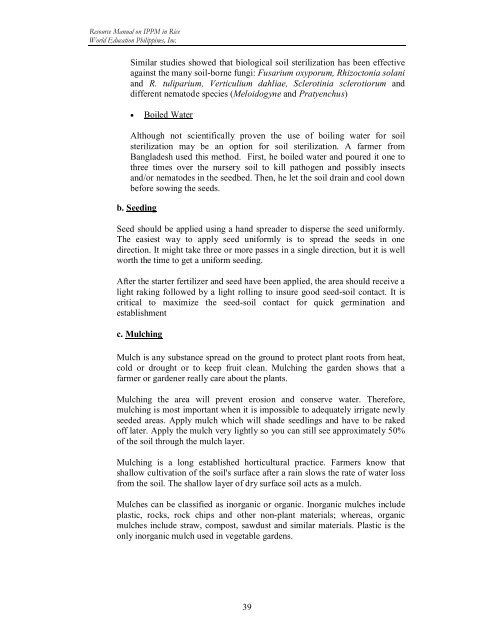(IPPM) in Vegetables - Vegetableipmasia.org
(IPPM) in Vegetables - Vegetableipmasia.org
(IPPM) in Vegetables - Vegetableipmasia.org
Create successful ePaper yourself
Turn your PDF publications into a flip-book with our unique Google optimized e-Paper software.
Resource Manual on <strong>IPPM</strong> <strong>in</strong> Rice<br />
World Education Philipp<strong>in</strong>es, Inc.<br />
Similar studies showed that biological soil sterilization has been effective<br />
aga<strong>in</strong>st the many soil-borne fungi: Fusarium oxyporum, Rhizoctonia solani<br />
and R. tuliparium, Verticulium dahliae, Sclerot<strong>in</strong>ia sclerotiorum and<br />
different nematode species (Meloidogyne and Pratyenchus)<br />
· Boiled Water<br />
Although not scientifically proven the use of boil<strong>in</strong>g water for soil<br />
sterilization may be an option for soil sterilization. A farmer from<br />
Bangladesh used this method. First, he boiled water and poured it one to<br />
three times over the nursery soil to kill pathogen and possibly <strong>in</strong>sects<br />
and/or nematodes <strong>in</strong> the seedbed. Then, he let the soil dra<strong>in</strong> and cool down<br />
before sow<strong>in</strong>g the seeds.<br />
b. Seed<strong>in</strong>g<br />
Seed should be applied us<strong>in</strong>g a hand spreader to disperse the seed uniformly.<br />
The easiest way to apply seed uniformly is to spread the seeds <strong>in</strong> one<br />
direction. It might take three or more passes <strong>in</strong> a s<strong>in</strong>gle direction, but it is well<br />
worth the time to get a uniform seed<strong>in</strong>g.<br />
After the starter fertilizer and seed have been applied, the area should receive a<br />
light rak<strong>in</strong>g followed by a light roll<strong>in</strong>g to <strong>in</strong>sure good seed-soil contact. It is<br />
critical to maximize the seed-soil contact for quick germ<strong>in</strong>ation and<br />
establishment<br />
c. Mulch<strong>in</strong>g<br />
Mulch is any substance spread on the ground to protect plant roots from heat,<br />
cold or drought or to keep fruit clean. Mulch<strong>in</strong>g the garden shows that a<br />
farmer or gardener really care about the plants.<br />
Mulch<strong>in</strong>g the area will prevent erosion and conserve water. Therefore,<br />
mulch<strong>in</strong>g is most important when it is impossible to adequately irrigate newly<br />
seeded areas. Apply mulch which will shade seedl<strong>in</strong>gs and have to be raked<br />
off later. Apply the mulch very lightly so you can still see approximately 50%<br />
of the soil through the mulch layer.<br />
Mulch<strong>in</strong>g is a long established horticultural practice. Farmers know that<br />
shallow cultivation of the soil's surface after a ra<strong>in</strong> slows the rate of water loss<br />
from the soil. The shallow layer of dry surface soil acts as a mulch.<br />
Mulches can be classified as <strong>in</strong><strong>org</strong>anic or <strong>org</strong>anic. In<strong>org</strong>anic mulches <strong>in</strong>clude<br />
plastic, rocks, rock chips and other non-plant materials; whereas, <strong>org</strong>anic<br />
mulches <strong>in</strong>clude straw, compost, sawdust and similar materials. Plastic is the<br />
only <strong>in</strong><strong>org</strong>anic mulch used <strong>in</strong> vegetable gardens.<br />
39




![Section 4 [ PDF file, 252 KB] - The Field Alliance](https://img.yumpu.com/51387260/1/158x260/section-4-pdf-file-252-kb-the-field-alliance.jpg?quality=85)












